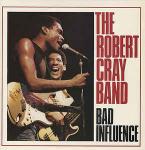The Robert Cray Band - Bad Influence - Demon Records - Blues
 |
Out of Stock |
Track ListingA1 Phone Booth (3:32)A2 Bad Influence (2:56) A3 The Grinder (4:09) A4 Got To Make A Comeback (5:52) A5 So Many Woman, So Little Time (4:01) B1 Where Do I Go From Here (4:03) B2 Waiting For The Tide To Turn (3:31) B3 March On (2:25) B4 Don't Touch Me (3:25) B5 No Big Deal (4:14) Media Condition » Near Mint (NM or M-) Sleeve Condition » Very Good (VG) |
|
| Artist | The Robert Cray Band | ||
| Title | Bad Influence | ||
| Label | Demon Records | ||
| Catalogue | FIEND 23 | ||
| Format | Vinyl Album | ||
| Released | 1984 | ||
| Genre | Blues |
Other Titles by The Robert Cray Band
• Acting This Way • I Guess I Showed Her • I Guess I Showed Her • Don't Be Afraid Of The Dark • False Accusations • Who's Been Talkin' •
Some Other Artists in the Blues Genre• B.B. King • Gary Moore • Willie And The Poor Boys • Lonnie Mack • Billie Holiday • Pete Seeger • Paul Roberts (4) • Sonny Terry & Brownie McGhee • Doug MacLeod • Randy Weston • Stevie Ray Vaughan & Double Trouble • The Milcho Leviev Quartet • Sister Rosetta Tharpe & The Gospel Tabernacle Choir And Players • Chris Rea • Mighty Joe Young • Robert Cray • Albert Collins And The Icebreakers • Albert Collins & Robert Cray & Johnny Copeland • Big Brother & The Holding Company • Ben E. King • Buddy Guy • Elmore James • The Blues Brothers • Creedence Clearwater Revival • Juicy Lucy • Annette Peacock • Albert King • Johnny Mars • Little Milton • Larry McCray • Robert Cray Band, The • John Lee Hooker • J.J. Cale • |
Some Other Artists on the Demon Records Label• Lamont Dozier • Men They Couldn't Hang, The • The Persuasions • Graham Parker • Elvis Costello And The Attractions* • Ian Dury And The Blockheads • That Petrol Emotion • |
Information on the Blues Genre
Blues is the name given to both a musical form and a music genre that originated in African-American communities of primarily the Deep South of the United States at the end of the 19th century from spirituals, work songs, field hollers, shouts and chants, and rhymed simple narrative ballads. The blues form, ubiquitous in jazz, rhythm and blues, and rock and roll, is characterized by specific chord progressions, of which the twelve-bar blues chord progression is the most common. The blue notes that, for expressive purposes are sung or played flattened or gradually bent (minor 3rd to major 3rd) in relation to the pitch of the major scale, are also an important part of the sound.The blues genre is based on the blues form but possesses other characteristics such as specific lyrics, bass lines and instruments. Blues can be subdivided into several subgenres ranging from country to urban blues that were more or less popular during different periods of the 20th century. Best known are the Delta, Piedmont, Jump and Chicago blues styles. World War II marked the transition from acoustic to electric blues and the progressive opening of blues music to a wider audience. In the 1960s and 1970s, a hybrid form called blues-rock evolved.
The term "the blues" refers to the "blue devils", meaning melancholy and sadness; an early use of the term in this sense is found in George Colman's one-act farce Blue Devils (1798). Though the use of the phrase in African-American music may be older, it has been attested to since 1912, when Hart Wand's "Dallas Blues" became the first copyrighted blues composition. In lyrics the phrase is often used to describe a depressed mood.
Data from the Discogs music database. Submit a Release.

